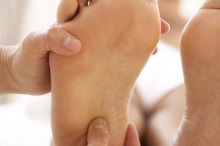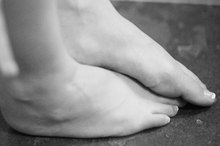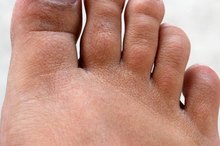Numbness in Feet and Calves While Running
If you're new to running, have bumped up your mileage or running intensity, changed surfaces or train in shoes that have lost their cushioning, various leg aches and pains are almost inevitable. But soreness and injury aren't the only things that can hold your running back. Numbness in the lower leg is common in runners and can signal a shoe problem or an underlying neurological or vascular disorder.
Intermittent Claudication
Intermittent claudication is a manifestation of peripheral artery disease, commonly abbreviated PAD. The term refers to pain and numbness with activities such as walking or running, usually in the calf. It is most often a result of arteries being narrowed or clogged as a result of atherosclerosis, or fatty deposits within the arteries. Most people don't have symptoms when at rest, and when they stop walking or running, the numbness rapidly disappears. If you have PAD, your doctor may prescribe a number of medications aimed both at relieving symptoms and eliminating the underlying cause.
- Intermittent claudication is a manifestation of peripheral artery disease, commonly abbreviated PAD.
- Most people don't have symptoms when at rest, and when they stop walking or running, the numbness rapidly disappears.
Tarsal Tunnel Syndrome
The Bottom of My Foot Gets Numb When Running
Learn More
Tarsal tunnel syndrome is anatomically analagous to, though not as well-known as, carpal tunnel syndrome of the wrist. Numbness in this case is usually limited to the bottom of the heel. This malady is caused by something -- a cyst, a bone spur or some other lesion -- impinging on the posterior tibial nerve. Biomechanical problems such as overpronation can also predispose runners to tarsal tunnel syndrome. Treatment includes some combination of orthotic shoe inserts, taking a break from running, corticosteroid shots, and, if indicated, surgery to remove the offending structure.
- Tarsal tunnel syndrome is anatomically analagous to, though not as well-known as, carpal tunnel syndrome of the wrist.
Morton's Neuroma
A neuroma is a pathological enlargement of the tissue layer surrounding a neuron. This often happens in the nerve that innervates the third and fourth toes and runs along the groove between them; the resulting lump is called a Morton's neuroma. Overpronators or people with aberrational toes -- for example, "hammer toes" -- are at greater risk for developing a Morton's neuroma, which causes pain and numbness in the third and fourth toes and, in most cases, the ball of the foot. Ultrasound energy often alleviates the problem, and metatarsal cushioning pads or orthotics can help prevent a recurrence.
- A neuroma is a pathological enlargement of the tissue layer surrounding a neuron.
- Overpronators or people with aberrational toes -- for example, "hammer toes" -- are at greater risk for developing a Morton's neuroma, which causes pain and numbness in the third and fourth toes and, in most cases, the ball of the foot.
Tight Shoes or Shoelaces
Numb Toes With Running Shoes
Learn More
Lacing your running shoes too tightly or wearing shoes that are too small or don't suit the unique shape of your foot or feet -- both very common situations -- can lead to numbness, chafing and pain. Most often, numbness of this type sets in and worsens throughout a run, and often affects the top of the foot. Laces pulled taut or in an unfavorable pattern compress the branch of the peroneal nerve supplying this area. To solve this problem, you can move up by half a shoe size, try a different lacing pattern or, if you use orthotics, remove or reposition them.
- Lacing your running shoes too tightly or wearing shoes that are too small or don't suit the unique shape of your foot or feet -- both very common situations -- can lead to numbness, chafing and pain.
Related Articles
References
- University of Rochester Medical Center; Peripheral Vascular Disease
- "Running Times": Ask the Coaches: Tarsal Tunnel Syndrome
- Holowka NB, Wallace IJ, Lieberman DE. Foot strength and stiffness are related to footwear use in a comparison of minimally- vs. conventionally-shod populations. Sci Rep. 2018;8(1):3679. doi:10.1038/s41598-018-21916-7
- Stanek JM. The Effectiveness of Compression Socks for Athletic Performance and Recovery. J Sport Rehabil. 2017;26(1):109-114. doi:10.1123/jsr.2015-0048
- American Diabetes Association. Peripheral Neuropathy. Dec 5, 2013.
- Holowka NB, Wallace IJ, Lieberman DE. Foot strength and stiffness are related to footwear use in a comparison of minimally- vs. conventionally-shod populations. Sci Rep. 2018;8(1):3679.
- Mayo Clinic, "Morton's neuroma"
- Mayo Clinic, "Peripheral neuropathy"
- Sanford Health, "Five ways to reduce over-striding"
- Science Direct, "Tarsal Tunnel Syndrome"
- SELF, "WTF Is Gluteal Amnesia and How to Know if You Have It." May 9, 2017
- Stanek JM. The Effectiveness of Compression Socks for Athletic Performance and Recovery. J Sport Rehabil. 2017;26(1):109-114.
Writer Bio
L.T. Davidson has been a professional writer and editor since 1994. He has been published in "Triathlete," "Men's Fitness" and "Competitor." A former elite cyclist with a Master of Science in exercise physiology from the University of Miami, Davidson is now in the broadcast news business.









